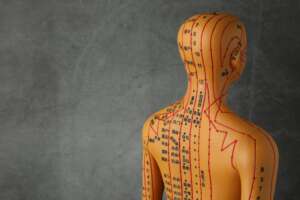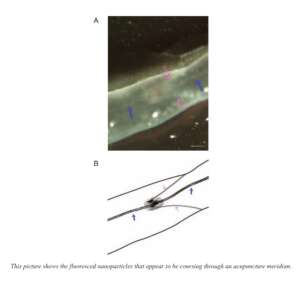
East Asian Medicine believes that energy (also referred to as qi) flows throughout the body much like blood does. When this flow of energy becomes disrupted, symptoms and disease can occur. Acupuncture and other forms of Eastern medicine work to restore the flow of energy throughout the body using the meridian system.
Meridians are basically the circulatory system of energy, similar to the circulatory system of the blood. Meridians allow the flow of the vital energy called Qi (pronounced ‘chee’) throughout the body.
Meridians are both simple and very complex. There are several concepts connected to the whole system. One example is the flow of energy. The meridian system utilizes yin and yang duality. The yin energy radiates outward, while the yang energy returns to the core.
Another concept involving the flow of energy is the Chinese term for meridians, jing luo. Jing means “to pass through”. It refers to the vertical meridian passages. Luo relates to the connecting tributaries. Together, they translate to “channel network.”
Acupuncture and the meridian system has a long history that dates back over 2,500 years ago. Acupuncture is one the oldest practices in East Asian Medicine (EAM) along with moxibustion, which is a type of heat therapy that is also thought to influence qi.
While it is unclear whether acupuncture originated in China, its practice is well documented. The oldest ancient text that references acupuncture dates back to 100 B.C., and other texts dating back to 600-500 B.C. reference acupuncture points without procedures. Archaeologists found gold and silver needle artifacts for acupuncture in ancient tombs. The needles and the texts mentioned are the first documentation of the already established practice.
Yet, there is some dispute about the exact origin date of the system of acupuncture. An ancient mummy called Otzi the Iceman was found in the Otzial Alps of Austria and the mummy dates back to the Bronze Age, around 3,300 B.C. This mummy had tattoos on his body that corresponded to meridian points on the lower back. Some archaeologists suggest this is evidence of acupuncture practices. But, without further documentation, we cannot know for sure.
Regardless, by the 4th century A.D., most modern acupuncture points had been identified with documentation and the highest levels of medieval Chinese society used acupuncture. The emperors of many dynasties even kept acupuncturists on retainer.
Medieval Chinese medical colleges even taught courses in acupuncture and the Meridian System. During the Ming Dynasty, “The Great Compendium of Acupuncture and Moxibustion ” established most of the acupuncture practices still used today.
But around the 13th century, acupuncture usage began to decline. It became associated with mysticism and was temporarily seen as a less legitimate practice. Following modern, scientific medicine, acupuncture became known as a lost art in China. However, right around this time, acupuncture started to see a surge of usage in Europe. Still, Western medicine viewed acupuncture with some suspicion. The focus on energetic and symbolic systems felt too superstitious. By the mid-19th century, Western interest in acupuncture had waned significantly.
It was not until the mid-20th century that acupuncture would make a comeback. Mao Zedong endorsed acupuncture to unite communist China behind a shared cultural history. By the 1950’s, Chinese hospitals began using acupuncture to treat patients. Modern research also began to examine acupuncture from a rational, scientific standpoint. And in 1997, the National Institutes of Health recommended acupuncture as a complementary treatment. Since then, acupuncture has become the most popular alternative medicine in the US.
But what about meridians? Until now, meridians have commonly been viewed as a metaphor or an ancient theory of how the body works that was developed before the advent of modern medicine. These mysterious structures were first proposed in the 1960’s by Bong Han Kim, who claimed they floated inside blood and lymph vessels and formed a network throughout the body. However, until recently, no one had been able to produce solid evidence of their existence.
But researchers are finding evidence of structures in the human body that could be analogous to meridians and some have demonstrated the existence of acupuncture points. These discoveries could ultimately help us better understand how acupuncture and EAM work.
New studies are showing that the existence of a newly discovered bodily system called the primo vascular system could be the physical basis of meridians. Although the discovery is still in its infancy, it has been shown that the primo vascular system connects the cardiovascular, nervous, immune, gastrointestinal and hormonal systems, making it essentially responsible for all major physiological functions and a likely candidate for meridians and acupuncture points alike.
Related to the discovery of the primo vascular system, other researchers have found evidence of acupuncture points (aka acupoints) as exhibited by structural differences at the sites of known acupoints versus the surrounding tissue. CT scans have revealed that acupoints have a higher density of microvessels and a large amount of complex microvascular structures compared to non-acupoint areas. Other research using a specialized oxygen microsensor demonstrates a similar finding.
This is where nanotechnology is proving beneficial. By injecting fluorescent magnetic nanoparticles into lymph nodes and applying magnetic fields, scientists have been able to visualize these elusive structures for the first time. These nanoparticles, usually used for cellular-scale research, have opened the door to an unexplored territory, revealing threadlike structures that measure approximately 20 micrometers in thickness, previously undetectable with a light microscope.

The discovery of the primo vascular system, the confirmation of acupoints existence and the use of nanotechnology to help visualize meridians all provide brilliant insights into how acupuncture and EAM work. It also demonstrates the true depth of knowledge and wisdom that ancient healers possessed. It makes their discoveries that much more admirable, given how much they were able to glean from simple observation and careful trial and error. Hopefully, with continued research we can one day fully understand the mechanisms of acupuncture and EAM.
In our post next week, we will discuss the 14 primary meridians and their specific attributes. Stay tuned!!

